According an aggregate polling website, FiveThirtyEight, there is a wide disparity between college presidents who believe sexual assault is a issue on college campuses, and those who believe that it’s happening at their schools.
These results were found in Inside Higher Ed’s annual Survey of College and University Presidents. This survey was not specific to sexual assault on college campuses.
Out of the 647 college presidents surveyed, 24 percent acknowledge sexual assault is prevalent on college campuses in the U.S., while only six percent admitted it was a problem at their own schools.
This finding proves there is a profound disconnect between the students and university executives. It’s easy to blame others while failing to look inward. There’s no question sexual assault is a larger issue for college campuses and more than six percent of university presidents should admit to it being an issue at their schools.
“Four percent were willing to say their school was doing an inadequate job of protecting women from sexual assault, 77 percent told Inside Higher Ed that their schools are doing a good job and 19 percent were neutral on the question,” FiveThirtyEight data reporter intern, Hayley Munguia, said.
College presidents want to put up a façade that their school is great, but we have to ask: Is publicity more important than student safety?
“They must be unaware of cases because it happens more than that (referring to the six percent),” health communications senior Michelle Jacobs said. “Sexual assault is a self-reported thing. If it is not reported, how are the presidents to know? Maybe they are a little too focused on the politics, if you say there is a sexual assault issue, less people are going to come to the school and as a result, the school will get less funding.”
Jacobs suggests better communication between the health and psychology offices and the president. She believes there is a way to bridge the disparity of knowledge, without compromising privacy or confidentiality.
If presidents are exaggerating their abilities to protect women from sexual assault or are minimizing their inadequacies by denying these issues, how can any reform or justice be accomplished?
Unfortunately, just as there is a stigma about reporting rape and other sex crimes, there is a stigma about colleges admitting it is a problem on campus as well. There shouldn’t be any stigma, there should only be proactive steps to end it.
There is nothing wrong with admitting these issues. Students come to college for a degree they can be proud of. If a school is good, students will flock. If a college has a bad reputation for sexual assault, it should focus on increasing safety measures near campus. It needs to show the students and public the initiative being taken to better the situation not hide behind statistics.
It’s no secret sexual assault and other related crimes have been prevalent at San Diego State in previous semesters. But unfortunately, it wasn’t the first time sexual assault crimes were committed, on or near campus, and it won’t be the last. With institutionalized patriarchal values and stigma toward sexual assault victims, it may prove difficult to fully expose the issue of sexual assault.
Great measures have been taken by the school to improve student safety. Student protests against sexual assault on campus and other groups called upon both the student body and SDSU Police Department to better their knowledge about sexual assault prevention and handling.
Those protests gained a lot of attention. It was impossible to ignore them. SDSU could not sweep the recent sexual assaults under the rug anymore and was forced to face last semester by the protesters, student body, and media.
According the National Sexual Violence Resource Center, one out of five women and one out of 16 men are sexually assaulted in college. Furthermore, rape is the No.1 unreported crime, as more than 90 percent of sexual assaults on college campuses go unreported.
The main thing we need to do is change the conversation.
The problem won’t be solved until it is actually recognized as a problem. On one hand, some students don’t know what exactly constitutes as sexual assault. While on the other hand, responsible citizens should take accountability for their actions. If something feels wrong, it’s probably smart to just not do it.
It may also be a good idea to do other investigations as to why there is such a divide between the students and the college presidents. To best serve their students, presidents should become more in the know and connected to the student body. They need to represent the students they govern, and by consequence, the issues.









